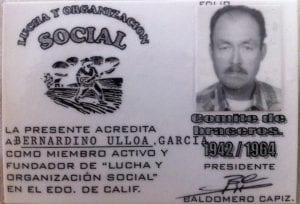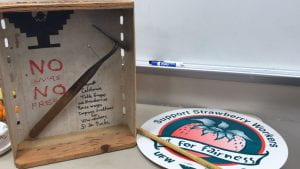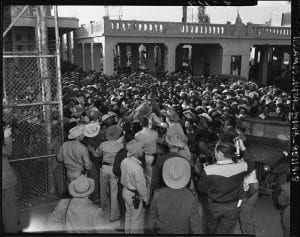 What was the Bracero Program, and why is it important to recognize its importance beyond the World War II era? How did the program change over time? The Bracero Program began during WWII but it spanned 22 years (1942-1964). What are the lasting legacies of the Bracero Program for Mexican Americans, and all immigrants, in the United States today?
What was the Bracero Program, and why is it important to recognize its importance beyond the World War II era? How did the program change over time? The Bracero Program began during WWII but it spanned 22 years (1942-1964). What are the lasting legacies of the Bracero Program for Mexican Americans, and all immigrants, in the United States today?
Educators from CLIC region 5, a collaboration of counties and school districts, met at the Monterey County Office of Education in January 2020 in a day-long session focused on answering these and other questions relating to the Bracero Program and teaching it in the classroom.
The day was fast-paced and exciting as we learned from each other and engaged in several activities. One of those activities was my lecture that explored more closely the many facets of the program. I discussed the Mexican government’s willingness to participate in the program because it positioned them as contributing to the fight against fascism and that they also viewed it as a way to improve and develop their own countryside. I also discussed how the Program changed over time and the impact of these changes on the treatment of the Braceros. The California History-Social Science framework incorporates the program in the WWII era, but it’s important to know how it affected the 1950s and 1960s as well.
 My lecture concluded with the lasting legacies of the Program, both historically and for people of Mexican descent living in the United States today. Many Mexican Americans can trace their family’s migration histories back to the program. Some of our parents, grandparents or great-grandparents might have participated in the program and the inclusion of the program into U.S history classes makes them more relevant and personal to us. In fact, as the day progressed educators in the room shared their own family’s histories with the Bracero Program! One person brought in the short-handled hoe her grandfather had used as a bracero while another shared her grandfather’s social club membership ID card! Others shared anecdotes of their family members experiences and histories. This was a highlight of the day!
My lecture concluded with the lasting legacies of the Program, both historically and for people of Mexican descent living in the United States today. Many Mexican Americans can trace their family’s migration histories back to the program. Some of our parents, grandparents or great-grandparents might have participated in the program and the inclusion of the program into U.S history classes makes them more relevant and personal to us. In fact, as the day progressed educators in the room shared their own family’s histories with the Bracero Program! One person brought in the short-handled hoe her grandfather had used as a bracero while another shared her grandfather’s social club membership ID card! Others shared anecdotes of their family members experiences and histories. This was a highlight of the day!


Throughout the day, we also explored the question: How might I teach about the Bracero Program?
We looked at the resources at the statewide CLIC website and sample curricula (the Smithsonian’s short handled hoe activities are some of our favorites). We also perused this folder of resources that we here at the HCP@UCSC compiled. Our morning ended, and afternoon began, with participating in model activities that demonstrated how to integrate ELD with using primary sources to investigate and learn about the past.
We had educators from across Santa Clara, Santa Cruz and Monterey County join us for this CLIC Region 5 professional learning day. We loved the opportunity to discuss such an important and relevant topic with so many educators!
****************************************
Below is a photo we investigated. What do you notice about this photo? What do you think about it?
What do you wonder?

You might be surprised to know this is a picture taken at the U.S.-Mexico border in 1954, and US border agents are trying to stop Mexican Braceros from coming into the United States!